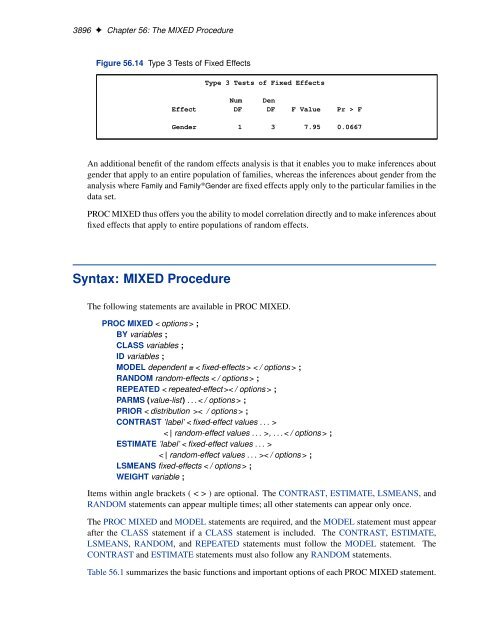SAS/STAT 9.2 User's Guide: The MIXED Procedure (Book Excerpt)
SAS/STAT 9.2 User's Guide: The MIXED Procedure (Book Excerpt)
SAS/STAT 9.2 User's Guide: The MIXED Procedure (Book Excerpt)
Create successful ePaper yourself
Turn your PDF publications into a flip-book with our unique Google optimized e-Paper software.
3896 ✦ Chapter 56: <strong>The</strong> <strong>MIXED</strong> <strong>Procedure</strong><br />
Figure 56.14 Type 3 Tests of Fixed Effects<br />
Type 3 Tests of Fixed Effects<br />
Num Den<br />
Effect DF DF F Value Pr > F<br />
Gender 1 3 7.95 0.0667<br />
An additional benefit of the random effects analysis is that it enables you to make inferences about<br />
gender that apply to an entire population of families, whereas the inferences about gender from the<br />
analysis where Family and Family*Gender are fixed effects apply only to the particular families in the<br />
data set.<br />
PROC <strong>MIXED</strong> thus offers you the ability to model correlation directly and to make inferences about<br />
fixed effects that apply to entire populations of random effects.<br />
Syntax: <strong>MIXED</strong> <strong>Procedure</strong><br />
<strong>The</strong> following statements are available in PROC <strong>MIXED</strong>.<br />
PROC <strong>MIXED</strong> < options > ;<br />
BY variables ;<br />
CLASS variables ;<br />
ID variables ;<br />
MODEL dependent = < fixed-effects > < / options > ;<br />
RANDOM random-effects < / options > ;<br />
REPEATED < repeated-effect >< / options > ;<br />
PARMS (value-list) . . . < / options > ;<br />
PRIOR < distribution >< / options > ;<br />
CONTRAST ’label’ < fixed-effect values . . . ><br />
< | random-effect values . . . >, . . . < / options > ;<br />
ESTIMATE ’label’ < fixed-effect values . . . ><br />
< | random-effect values . . . >< / options > ;<br />
LSMEANS fixed-effects < / options > ;<br />
WEIGHT variable ;<br />
Items within angle brackets ( < > ) are optional. <strong>The</strong> CONTRAST, ESTIMATE, LSMEANS, and<br />
RANDOM statements can appear multiple times; all other statements can appear only once.<br />
<strong>The</strong> PROC <strong>MIXED</strong> and MODEL statements are required, and the MODEL statement must appear<br />
after the CLASS statement if a CLASS statement is included. <strong>The</strong> CONTRAST, ESTIMATE,<br />
LSMEANS, RANDOM, and REPEATED statements must follow the MODEL statement. <strong>The</strong><br />
CONTRAST and ESTIMATE statements must also follow any RANDOM statements.<br />
Table 56.1 summarizes the basic functions and important options of each PROC <strong>MIXED</strong> statement.

















